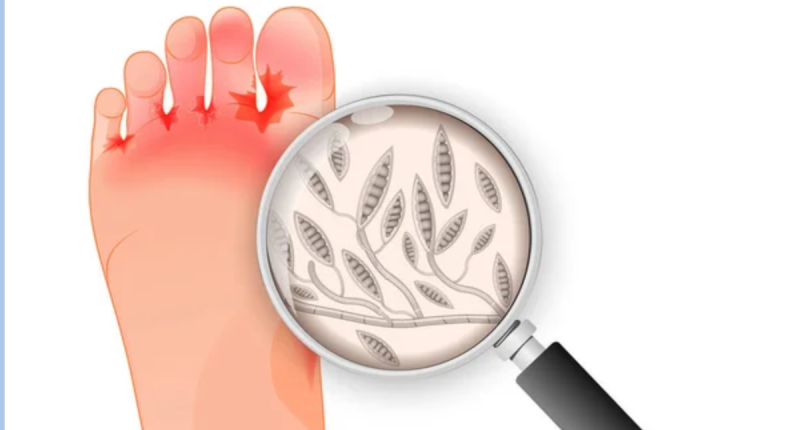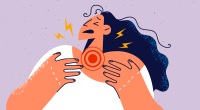Athlete’s foot condition is most common between the toes, but it can also affect the tops and soles of the feet. The infection thrives in warm, moist environments, such as the inside of shoes and socks.
Athlete’s foot is contagious and can be spread through contact with an infected person or through contact with contaminated surfaces, such as towels, floors, and shoes. It is also possible to spread athlete’s foot from the feet to other parts of the body, such as the hands and groin.
Types of Athlete’s Foot
There are four main types of athlete’s foot:
- Interdigital athlete’s foot: This is the most common type of athlete’s foot and affects the skin between the toes. It is characterized by itching, redness, and scaling.
- Moccasin athlete’s foot: This type of athlete’s foot affects the soles of the feet and can spread to the heels and sides of the feet. It is characterized by dry, thickened skin that may be cracked or peeling.
- Vesicular athlete’s foot: This type of athlete’s foot is characterized by fluid-filled blisters that may appear on the soles, sides, or tops of the feet.
- Ulcerative athlete’s foot: This is the most severe type of athlete’s foot and can lead to open sores on the feet. It is most common in people with diabetes or other conditions that weaken the immune system.
Which type of athlete’s foot condition you have will determine the best course of treatment. For example, an interdigital athlete’s foot can usually be treated with over-the-counter antifungal creams or powders. However, moccasin, vesicular, and ulcerative athlete’s foot may require prescription antifungal medications.
Don’t miss: 6 Daily Habits That Are Completely Destroying Your Feet

Symptoms of Athlete’s Foot
The symptoms of athlete’s foot can vary depending on the type of infection you have. However, some common symptoms include:
- Itching
- Burning
- Stinging
- Redness
- Scaliness
- Cracking
- Blisters
- Dry, thickened skin
- Open sores (in severe cases)
The symptoms of athlete’s foot are often worse between the toes, but the infection can also affect the soles, sides, and tops of the feet.
Appointment with Doctor
You should see a doctor for athlete’s foot if:
- Your symptoms are severe or do not improve with over-the-counter medications.
- You have a weakened immune system, such as from diabetes or HIV/AIDS.
- You have other medical conditions, such as circulatory problems or peripheral neuropathy.
- The infection spreads to other parts of your body, such as your toenails or hands.
- You develop signs of a serious infection, such as fever, redness, swelling, or drainage from the affected area.
If you have any concerns about athlete’s foot, it is always best to see a doctor or podiatrist to get a diagnosis and treatment.
Causes
You can get athlete’s foot by:
- Walking barefoot in public places, such as locker rooms, swimming pools, and showers
- Sharing towels or clothing with someone who has athlete’s foot
- Trying on shoes without socks
- Wearing tight-fitting shoes or socks
- Having sweaty feet
- Having a weakened immune system
Risk Factors
Certain factors can increase your risk of developing athlete’s foot, including:
- Sweaty feet: Athlete’s foot thrives in warm, moist environments, so sweaty feet are a major risk factor.
- Wearing tight-fitting shoes or socks: Tight-fitting shoes and socks can trap moisture and heat, creating a perfect environment for the fungus to grow.
- Walking barefoot in public places: Athlete’s foot is contagious, and you can pick it up by walking barefoot in public places where the fungus is present, such as locker rooms, swimming pools, and showers.
- Sharing towels or clothing with someone who has athlete’s foot: Athlete’s foot can be spread through contact with contaminated surfaces, such as towels and clothing.
- Having a weakened immune system: People with weakened immune systems are more likely to develop athlete’s foot. This is because their immune system is less able to fight off the fungus.
Other risk factors for athlete’s foot condition include:
- Age: Athlete’s foot is more common in adults than in children.
- Gender: Athlete’s foot is more common in men than in women.
- Occupation: People who work in certain occupations, such as athletes and construction workers, are at increased risk of developing athlete’s foot. This is because they are more likely to be exposed to the fungus and to have sweaty feet.
If you have any of the risk factors for athlete’s foot, it is important to take steps to prevent the infection.
Diagnosis
Athlete’s foot is typically diagnosed by a doctor or podiatrist based on a physical examination of the feet. The doctor will look for signs and symptoms of the infection, such as itching, redness, scaling, cracking, and blisters.
In some cases, the doctor may also order a test to confirm the diagnosis. This test may involve taking a scraping of the affected skin and examining it under a microscope for the presence of fungus.
If you have any of the symptoms of athlete’s foot, it is important to see a doctor or podiatrist to get a diagnosis and treatment. Athlete’s foot is a contagious infection, so it is important to treat it promptly to prevent it from spreading to other parts of your body or to other people.
Here are some tips for preparing for your doctor’s appointment:
- Make a list of all of your symptoms, including when they started and how often they occur.
- Write down any medications or supplements you are taking.
- Bring any shoes or socks that you think may be contributing to the infection.
At your appointment, your doctor will ask you questions about your symptoms, medical history, and lifestyle. They will also examine your feet carefully.
If your doctor suspects that you have athlete’s foot, they may order a test to confirm the diagnosis. This test may involve taking a scraping of the affected skin and examining it under a microscope for the presence of fungus.
Once your doctor has confirmed the diagnosis, they will recommend a treatment plan.
Treatment for Athlete’s Foot
There are a number of over-the-counter and prescription medications that can be used to treat athlete’s foot. The best course of treatment for you will depend on the severity of your infection and your overall health.
Over-the-counter medications for athlete’s foot
Over-the-counter medications for athlete’s foot typically contain antifungal ingredients such as clotrimazole, miconazole, or terbinafine. These medications are available in a variety of forms, including creams, ointments, powders, and sprays.
To use an over-the-counter antifungal medication for athlete’s foot, simply follow the directions on the label. Be sure to apply the medication to the affected area and to the surrounding skin. You may need to apply the medication twice a day for several weeks to clear the infection.
Prescription medications for athlete’s foot
If your athlete’s foot infection is severe or does not respond to over-the-counter medications, your doctor may prescribe a prescription antifungal medication. Prescription antifungal medications are available in a variety of forms, including oral tablets, topical creams, and ointments.
Oral antifungal medications are typically taken for one to two weeks. Topical antifungal creams and ointments are typically applied to the affected area once or twice a day for several weeks.
Other treatments for athlete’s foot
In addition to antifungal medications, your doctor may also recommend other treatments for athlete’s foot, such as:
- Soaking your feet in cool water: Soaking your feet in cool water can help to relieve itching and burning. To soak your feet, simply fill a basin with cool water and soak your feet for 15-20 minutes.
- Applying a bandage to the affected area: Applying a bandage to the affected area can help to protect the skin and prevent the infection from spreading.
- Wearing loose-fitting, breathable shoes and socks: Wearing loose-fitting, breathable shoes and socks can help to keep your feet dry and prevent sweat from accumulating.
Don’t miss: 3 Precautionary Measurements You Can Take To Protect You From Germs
Prevention and Management Tips
Here are some tips for managing the symptoms of athlete’s foot:
- Wash your feet daily with soap and water, especially between the toes.
- Dry your feet thoroughly, especially between the toes.
- Wear loose-fitting shoes and socks that are made of breathable materials.
- Avoid wearing the same shoes two days in a row.
- Change your socks daily.
- Avoid walking barefoot in public places.
- Apply over-the-counter antifungal creams or powders to the affected area.
- Soak your feet in cool water for 15-20 minutes at a time to relieve itching and burning.
If your symptoms are severe or do not respond to over-the-counter medications, your doctor may prescribe prescription antifungal medications.
Home Remedies for Athlete’s Foot
There are a number of home remedies that can help to relieve the symptoms of athlete’s foot and promote healing. However, it is important to note that home remedies should not be used as a substitute for medical treatment. If your athlete’s foot infection is severe or does not respond to home remedies, see a doctor or podiatrist.
Here are some home remedies for athlete’s foot:
- Soaking your feet in cool water: Soaking your feet in cool water can help to relieve itching and burning. To soak your feet, simply fill a basin with cool water and soak your feet for 15-20 minutes.
- Applying a vinegar solution to the affected area: Vinegar has antifungal properties and can help to kill the fungus that causes athlete’s foot. To apply a vinegar solution to the affected area, mix equal parts vinegar and water. Apply the solution to the affected area with a cotton ball or gauze pad. Let the solution sit on the skin for 10-15 minutes before rinsing it off with water.
- Applying a baking soda paste to the affected area: Baking soda can help to absorb moisture and reduce inflammation. To apply a baking soda paste to the affected area, mix baking soda with water to form a paste. Apply the paste to the affected area and let it sit for 10-15 minutes before rinsing it off with water.
- Applying tea tree oil to the affected area: Tea tree oil has antifungal properties and can help to kill the fungus that causes athlete’s foot. To apply tea tree oil to the affected area, mix one part tea tree oil with three parts water. Apply the mixture to the affected area with a cotton ball or gauze pad. Let the mixture sit on the skin for 10-15 minutes before rinsing it off with water.
You can use these home remedies once or twice a day until your athlete’s foot infection clears up.
Don’t miss: 20 everyday personal Items that can spread disease to you easily when you share
Complications
Athlete’s foot is a common fungal infection that can cause a variety of symptoms, including itching, burning, and scaling of the skin. In most cases, athlete’s foot is a mild condition that can be treated with over-the-counter antifungal medications. However, if left untreated, athlete’s foot can lead to complications, such as:
- Bacterial infection: Athlete’s foot can damage the skin, making it more vulnerable to bacterial infection. If a bacterial infection develops, the skin may become red, swollen, and painful.
- Spread of the infection: Athlete’s foot can spread to other parts of the body, such as the toenails, hands, and groin.
- Onychomycosis: Onychomycosis, also known as fungal nail infection, is a common complication of athlete’s foot. Onychomycosis can cause the toenails to become thick, discolored, and brittle.
- Cellulitis: Cellulitis is a serious bacterial infection of the skin that can develop if athlete’s foot is not treated. Cellulitis can cause redness, swelling, and pain in the affected area.
- Lymphangitis: Lymphangitis is an inflammation of the lymphatic vessels. It can develop if athlete’s foot spreads to the lymphatic system. Lymphangitis can cause redness, swelling, and pain along the affected lymphatic vessel.
If you have any concerns about athlete’s foot, or if you experience any of the complications listed above, it is important to see a doctor or podiatrist right away.
How to prevent complications
The best way to prevent complications from athlete’s foot condition is to treat the infection early. If you have any of the symptoms of athlete’s foot, see a doctor or podiatrist right away.
Can Athlete’s Foot Occur in Children?
Yes, athlete’s foot condition can occur in children. It is a common fungal infection that can affect people of all ages, but it is more common in children who are active and sweaty. Children are at increased risk of developing athlete’s foot because they are more likely to:
- Sweat a lot
- Wear tight-fitting shoes
- Walk barefoot in public places, such as swimming pools and locker rooms
- Share towels or clothing with someone who has athlete’s foot
The symptoms of athlete’s foot in children are the same as the symptoms of athlete’s foot in adults.
Athlete’s Foot and Diabetes
people with diabetes are at increased risk for developing this infection. This is because people with diabetes often have poor circulation and nerve damage in their feet, which can make it difficult for them to fight off infection.
Here are some of the reasons why athlete’s foot is more common in people with diabetes:
- Poor circulation: People with diabetes often have poor circulation in their feet. This is because high blood sugar levels can damage the blood vessels that supply blood to the feet. When blood circulation is poor, the feet are more susceptible to infection.
- Nerve damage: People with diabetes can also develop nerve damage in their feet. This is known as diabetic neuropathy. Diabetic neuropathy can cause numbness, tingling, and pain in the feet. It can also make it difficult for people with diabetes to feel cuts and sores on their feet. This can lead to infections that go unnoticed and untreated.
- High blood sugar levels: High blood sugar levels can weaken the immune system. This makes it more difficult for people with diabetes to fight off infection, including athlete’s foot.










